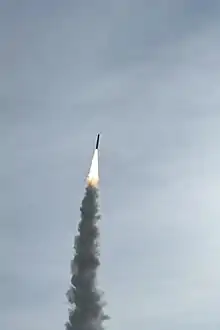 | |
| Type | Private |
|---|---|
| Industry | Telecommunications |
| Founded | 2015 |
| Founders | Mina Mitry, Wen Cheng Chong, Mark Michael, Jeffrey Osborne |
| Headquarters | Toronto, Ontario, Canada |
| Website | kepler.space |
Kepler Communications Inc. is a private telecommunications company based in Toronto, Ontario, Canada. The company's stated mission is to deliver affordable network connectivity across the globe via a growing network of small satellites.
Overview
Kepler Communications is working to build a constellation of small, shoebox-sized satellites based on the CubeSat standard to deliver connectivity to other satellites and ground-based stations, allowing for near real-time exchange of data from IoT devices, large scale data backhaul (store-and-forward) services, and ultimately command and control for other space-based assets.
The company hopes to grow their business around data backhaul services that will serve remote business operators, shippers, research stations, and entities engaged in resource exploration and gathering (mining, oil and gas) in remote locations. Their units are capable of high-bandwidth transfer, allowing them to move data that is too cumbersome for existing real-time satellite communications systems.[1]

Additionally, Kepler is working to establish, using the same platform of satellites, an Internet of Things (IoT) communication system that will ease the problems caused by a global disparity between established communications methods and protocols across regions (no antenna currently exists which can communicate across all existing cellular networks). This solution is designed to be a low-power, low-bandwidth, and low-cost connectivity platforms for IoT devices around the globe.
Kepler's key technology is a high-capacity, high-throughput software-defined radio (SDR) that can provide 200 MHz of bandwidth, allowing for data throughput of 500 megabits/second (Mbps) in communication speed.
Kepler Communications was founded in 2015 by four graduate students from the University of Toronto, who previously worked together on various design projects through the University of Toronto Aerospace Team. The startup was incubated at University of Toronto's Entrepreneurship Hatchery, the Creative Destruction Lab, Ryerson University's DMZ, and was part of the Techstars Seattle 2016 cohort. Kepler was able to raise $5M in a seed round financing at Techstars, and in the span of 12 months was able to take KIPP from design to orbit. In 2018, the company successfully completed their Series A financing round, raising a total of $16M USD. The round was led by Costanoa Ventures, with participation by Deutsche Bahn’s (DB) Digital Ventures as a strategic investor.
The company is named in honour of Johannes Kepler, a pioneer in the discovery of the way in which objects in space interact. He is best known for his Laws of Planetary Motion.
Satellites constellations
Kepler
Bearing the same name of the company, the Kepler constellation is a constellation of cubesats for Internet of Things (IoT), machine-to-machine (M2M) and inter-satellite communications services. The first three cubesats sent in orbit served as technology demonstrator and were built in a 3U format. The first two of them (KIPP and CASE) were built by AAC Clyde Space[2] while the third (TARS) by ÅAC Microtec,[3] and they have been named after the fictitious US Marine Corps robots of the same name in the 2014 film “Interstellar”.[4] KIPP and CASE, which travel at speeds in excess of 7 kilometers per second, have software installed to compensate for Doppler shift.[5]
The operational satellites are built on a 6U format and they're based on the Spartan cubesat platform, developed by Kepler Communicaitons in cooperation with UTIAS-SFL. As of April 2023 the constellation has grown to include, in addition to the three pathfinders, 18 operational satellites.[6] Company officials have stated a goal of growing their constellation up to 140 units, all located in Sun-Synchronous polar orbits, approximately 575 km above the Earth's surface.
| Name | COSPAR | Catalog N° | Launch date | Launch vehicle |
|---|---|---|---|---|
| Test satellites | ||||
| Kepler 0 KIPP | 2018-008D | 43157 | 19 January 2018 | Long March 11 |
| Kepler 1 CASE | 2018-096L | 43729 | 29 November 2018 | PSLV-CA |
| Kepler 2 TARS | 2020-061AZ | 46319 | 3 September 2020 | Falcon 9 Block 5 |
| Operational satellites | ||||
| Kepler 4 Antilles | 2020-068N | 46499 | 28 September 2020 | Falcon 9 Block 5 |
| Kepler 5 Amidala | 2020-068P | 46498 | ||
| Kepler 6 Rocinante | 2021-022Z | 47955 | 22 March 2021 | Soyuz-2.1a |
| Kepler 7 C3PO | 2021-022T | 47949 | ||
| Kepler 8 Amarok | 2021-006BR | 47476 | 24 January 2021 | Falcon 9 Block 5 |
| Kepler 9 Artemis | 2021-006DX | 47531 | ||
| Kepler 10 Baby Yoda | 2021-006CS | 47501 | ||
| Kepler 11 Daneel | 2021-006CU | 47503 | ||
| Kepler 12 Boba | 2021-006AK | 47446 | ||
| Kepler 13 Lucky | 2021-006AT | 47454 | ||
| Kepler 14 Stella | 2021-006DS | 47526 | ||
| Kepler 15 Sudormrf | 2021-006BA | 47461 | ||
| Kepler 16 Astraeus | 2022-002CB | 51057 | 13 January 2022 | Falcon 9 Block 5 |
| Kepler 17 Karina | 2022-002CD | 51059 | ||
| Kepler 18 Blip-A | 2022-002U | 51002 | ||
| Kepler 19 | 2022-002BV | 51051 | ||
| Kepler 20 | 2022-054AR | 56217 | 15 April 2023 | Falcon 9 Block 5 |
| Kepler 21 | 2023-054AS | 56218 | ||
Aether
The Aether constellation is composed of data relay satellites to provide in-space real-time connectivity for orbiting spacecraft moving past the need to rely on ground stations. [7] The data network, named The Kepler Network, will be able to provide data on-demand at up to 2.5 Gigabit-per-second for the end-user through a combination of optical, S-band, and Ku-band technologies.[8] Access to the network will be granted to third-party satellites equipped with the Aether terminal, successfully validated in 2022 with customers like Spire Global having already announced their will to install the terminals on their satellites.[9][10] The first two satellites of the constellation have been launched on 11 November 2023 as part of SpaceX Transporter-9 rideshare mission.[11]
| Name | COSPAR | Catalog N° | Launch date | Launch vehicle |
|---|---|---|---|---|
| Aether-1 | 2023-174AB | 58281 | 11 November 2023 | Falcon 9 Block 5 |
| Aether-2 | 2023-174AV | 58299 |
References
- ↑ "Kepler Communications Inc". www.keplercommunications.com. Retrieved 2019-06-12.
- ↑ Krebs, Gunter. "KIPP, CASE (Kepler 0, 1)". Gunter's Space Page. Retrieved 14 November 2023.
- ↑ Krebs, Gunter. "TARS (Kepler 2, IOD 5)". Gunter's Space Page. Retrieved 14 November 2023.
- ↑ Interstellar, retrieved 2019-06-12
- ↑ Mitry, Mina (2020). "Routers In Space". IEEE Spectrum. 57 (2): 43.
- ↑ Krebs, Gunter. "Kepler 4, ..., 21". Gunter's Space Page. Retrieved 14 November 2023.
- ↑ Rainbow, Jason (23 December 2021). "Kepler plots relay network to serve thousands of satellite terminals". SpaceNews.com. Retrieved 14 November 2023.
- ↑ "Kepler Selects TESAT to Provide Optical Terminals for Next Generation Constellation". SpaceRef. 8 June 2022. Retrieved 14 November 2023.
- ↑ Boucher, Mark (10 May 2022). "Spire Global to use Kepler Communications Aether-KU payload on up to 50 satellites". SpaceQ. Retrieved 14 November 2023.
- ↑ Rainbow, Jason (14 April 2022). "Kepler validates intersatellite data-relay terminal". SpaceNews.com. Retrieved 14 November 2023.
- ↑ Lentz, Danny (11 November 2023). "SpaceX Transporter 9 rideshare features new OTV from Tom Mueller's Impulse Space". NASASpaceFlight. Retrieved 11 November 2023.